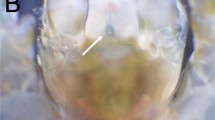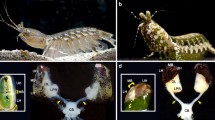Summary
A new photoreceptor in the Copepoda is described. The organ, previously called Gicklhorn's organ (Elofsson, 1966a), is paired and is usually situated beneath the cuticle of the front. Each member of the pair consists of two cells. From the anterolateral position, two nerves lead to the lateral part of the brain. No connexion with the nauplius eye is found. Each cell of the organ has microvilli, two nuclei, dictyosomes, and large cisternae of the endoplasmic reticulum. Except for the binucleated condition, the cells closely resemble the retinula cells of the copepod nauplius eye.
It is concluded that, because of its independent position, the new photoreceptor is not a detached part of the nauplius eye. As there are no accessory structures present and no missing links so far known, it is doubtful whether it can be regarded as a vestigial compound eye. The most plausible hypothesis is that the new presumed photoreceptor is an independent structure without connexions either with crustacean compound or nauplius eyes.
If the function of the nauplius eye is considered by itself the improvement contributed by the new organ is probably modest because of its low level of organization. Some experimental evidence on light reception in Copepods points to a possible function in response to directed light.
Similar content being viewed by others
References
Bohm, M. K., Parker, R. A.: The fine structure of daphnid supraoesophageal and optic ganglia, and its possible functional significance. J. Morph.126, 373–394 (1968).
Elofsson, R.: The nauplius eye and frontal organs in malacostraca (Crustacea). Sarsia19, 1–54 (1965).
—: The nauplius eye and frontal organs of the non-malacostraca (Crustacea). Sarsia25, 1–128 (1966a).
—: Some aspects of the fine structure of the nauplius eye ofPandalus borealis (Crustacea: Decapoda). Acta univ. Lund., Sect. II28, 1–16 (1966b).
—: The ultrastructure of the nauplius eye ofSapphirina (Crustacea: Copepoda). Z. Zellforsch.100, 376–401 (1969).
Esterly, C. O.: The light recipient organs of the copepod,Eucalanus elongatus. Bull. Mus. comp. Zool. Harv.53, 1–56 (1908).
Fahrenbach, W. H.: The biology of a harpacticoid copepod. Cellule62, 303–376 (1962).
—: The fine structure of a nauplius eye. Z. Zellforsch.62, 182–197 (1964).
Friedrich, H.: Mitteilungen über vergleichende Untersuchungen über den Lichtsinn einiger mariner Copepoden. Z. vergl. Physiol.15, 121–138 (1931).
Gall, J.-C., Grauvogel, L.: Un arthropode peu connu de genre Euthycarcinus Handlirsch. Annls Paléont.50, 3–18 (1964).
Gicklhorn, J.: Zur Kenntnis der Frontalorgane vonCyclops strenuus Fischer. Zool. Anz.90, 209–216 (1930).
Hamori, J., Horridge, G. A.: The lobster optic lamina I. General organization. J. Cell Sci.1, 249–256 (1966).
Handlirsch, A.: Eine interessante Crustaceenform aus der Trias der Vogesen. Verh. zool. bot. Ges. Wien64, 1–8 (1914).
Horridge, G. A., Barnard, P. B. T.: Movement of palisade in locust retinula cells when illuminated. Quart. J. micr. Sci.106, 131–135 (1965).
Jander, R.: Die Phylogenie von Orientierungsniechanismen der Arthropoden. Zool. Anz., Suppl.29, 266–306 (1966).
Lang, K.: Monographie der Harpacticiden Bd. 1, S. 1–896. Stockholm: Nordiska Bokhandeln 1948.
Millonig, G. J.: Advantages of a phosphate buffer for OsO4 solutions in fixation. J. appl. Phys.32, 1637 (1961).
Newstead, J. D., Dornfeld, E. J.: Epithelial structure in the anterior segment of the vas deferens of an isopod,Porcellio scaber (Latreille). Z. Zellforsch.68, 795–817 (1965).
Okuda, K.: Electron microscopic observations of the retinal pigment epithelium of vertebrate animals. Jap. J. Ophthal.6, 76–87 (1962).
Palmer, A. R.: Copepoda. In: Treatise on invertebrate paleontology. Part R, Arthopoda 4, 1 (ed. R. C. Moore), p. 200–203. Lawrence, Ka.: Univ. of Kansas Printing Service 1969.
Peracchia, C.: A system of parallel septa in crayfish nerve fibres. J. Cell Biol.44, 125–133 (1970).
Porter, K. R., Yamada, E.: Studies on the endoplasmic reticulum V. Its form and differentiation in pigment epithelial cells of the frog retina. J. biophys. biochem. Cytol.8, 181–205 (1960).
Röhlich, P., Törö, I.: Fine structure of the compound eye ofDaphnia in normal, dark- and strongly light-adapted state. In: The structure of the eye II. Symposium (ed. J. W. Rohen), p. 175–186. Stuttgart: F. K. Schattauer 1965.
Scharf, J.-H.: Nervensystem III Sensible Ganglien. In: Handbuch der mikroskopischen Anatomie des Menschen, (ed. W. Bargmann), Bd. 4, S. 214. Berlin-Göttingen-Heidelberg: Springer 1958.
Smith, D. S., Treherne, J. E.: Functional aspects of the organization of the insect nervous system. In: Advances in insect physiology 1 (ed. J. W. L. Beament, J. E. Treherne and V. B. Wiggelsworth), p. 401–484. London-New York: Academic Press 1963.
Spooner, G. M.: Observations on the reactions of marine plankton to light. J. mar. biol. Ass. U. K.19, 385–438 (1933).
Trujillo-Cenóz, O.: The fine structure of a special type of nerve fibre found in the ganglia ofArmadillidium vulgare (Crustacea-Isopoda). J. biophys. biochem. Cytol.7, 185–186 (1960).
Umminger, B. L.: Polarotaxis in copepods II. The ultrastructural basis and ecological significance of polarized light sensivity in copepods. Biol. Bull.135, 252–261 (1968).
Vaissière, R.: Morphologie et histologie comparées des yeux des Crustacés Copépodes. Arch. Zool. exp. gén.100, 1–126 (1961).
Yamada, E., Tokuyasu, K., Iwaki, S.: The fine structure of retina studied with electron microscope. J. Electron Microsc.6, 42–46 (1958).
Yamamoto, T., Tasaki, K., Sugawara, Y., Tonosaki, A.: Fine structure of the octopus retina. J. Cell Biol.25, 345–359 (1965).
Zonana, H. V.: Fine structure of the squid retina. Bull. Johns Hopk. Hosp.109, 185–205 (1961).
Author information
Authors and Affiliations
Additional information
This work was supported by a grant from the Swedish Natural Science Research Council 2760-3.
Rights and permissions
About this article
Cite this article
Elofsson, R. A presumed new photoreceptor in copepod crustaceans. Z.Zellforsch 109, 316–326 (1970). https://doi.org/10.1007/BF02226905
Received:
Issue Date:
DOI: https://doi.org/10.1007/BF02226905




